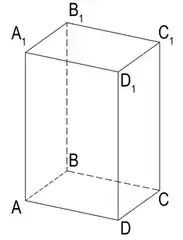In a math textbook for primary school, there's a picture like the one below. They explain which of the line segments are perpendicular and which are parallel to AD.
There's also a note stating that A1B1, D1C1, BB1 and CC1 are neither parallel nor perpendicular to AD.
I was wondering about that statement, because I learned that those four are perpendicular to AD. So I wrote to the book publisher asking about that. They replied that actually there are two conventions for this situation and they choose "not perpendicular" which, according to them, is more popular.
Is there really no consensus on that?
Edit:
I found another question here, related to a mathematical consensus: Is $0$ a natural number? and I'd accept an answer referring to some resources and clarifying whether the consensus exists or not.
